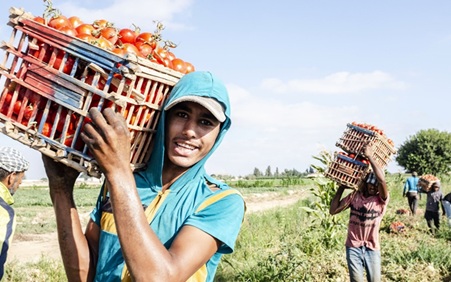(Prelims: Agriculture, Important Reports and Index)
(Mains, General Studies Paper- 2: Topics related to direct and indirect agricultural assistance and minimum support price; topics related to buffer stock and food security) |
Reference
Youth unemployment has become a serious challenge at the global level. According to a recent report released by the Food and Agriculture Organization (FAO) of the United Nations, Agri-Food Systems can increase global GDP by 1.4%, out of which 45% increase can be achieved through youth participation.

About Agri-Food Systems
- Definition: Agri-food systems are a comprehensive network that includes the process from agricultural production and waste management to food distribution, processing, marketing and delivery to consumers.
- Key Features
- Resource Management: Balanced use of land, water and energy
- Food Security: Availability of adequate, safe and nutritious food for all people
- Marketing and Supply Chain: Distribution and sale of agricultural produce at a fair price
- Employment Generation: Employment opportunities in various agriculture related activities
- Agri-technology: Increasing agricultural production and food security through new technologies
FAO Report on Agri-Food Systems
- Title: The Status of Youth in Agrifood Systems
- Objective: To emphasize the importance of agri-food systems in reducing unemployment among youth in the age group of 15-24 globally (including India)
Findings of the report at the global level
- High unemployment rate: According to the report, there are 1.3 billion youth in the age group of 15-24 years across the world, out of which 20% youth do not have any stable employment and they are in the NEET (Not in Employment, Education, or Training) category
- Decreasing youth participation in agriculture: In 2005, 54% of youth were employed in agri-food systems, which has now come down to 44%. The main reason for this is migration from rural areas to urban areas, which is causing a shortage of workforce in the agriculture sector.
- Agri-food systems and youth employment: 44% of working youth are associated with agri-food systems while this figure is 38% among adults. • Increase in global food insecurity: Globally, the rate of food insecurity among youth has increased from 16.7% in 2014-16 to 24.4% in 2021-23.
- Threat of decline in agricultural productivity: Climate change may lead to a decline in agricultural production, especially in sub-Saharan Africa and Asia.
- About 395 million rural youth are living in areas where agricultural productivity is likely to decline.
- Increasing urbanization: Today 54% of youth live in urban areas, while only 5% of the youth population living in rural areas is engaged in agriculture. This trend is causing a shortage of workers in the agricultural sector.
Report findings in India's perspective
- Unemployment rate: The unemployment rate in India is 7.5% by the year 2024, which is higher than the global level of 5.6%.
- Urbanization of youth: Due to the rapid increase in the rate of urbanization in India, the number of rural youth is decreasing and their participation in agri-food systems is decreasing.
- Employment generation for youth: Agri-food systems are the main source of employment for millions of youth in India. The rural economy here depends on agri-food systems but the participation of youth has decreased.
- Increasing food insecurity: Food insecurity is also increasing in India, especially in rural areas, where agri-food systems are the main source of livelihood for youth.
- Youth affected in vulnerable areas: The impact of climate change in rural areas of India is affecting agricultural activities and youth employment opportunities.
- New policies: Agri-food systems in India should be made more attractive for youth. For this, technology, training and reforms are needed.
- Investment in agriculture: India should increase investment in agri-food systems for youth, so that they can get stable and good employment opportunities.
Challenges
- Unemployment and NEET: 28.5% of youth in India and 20% in the world are NEET. Women are more affected by this.
- Urbanization: Rural youth are migrating to urban areas, causing a shortage of labor in agriculture.
- Climate change: 395 million rural youth are affected by extreme weather and climate change.
- Low income and insecure employment: 91% of young women and 83% of young men are engaged in insecure and seasonal jobs in the agriculture sector.
- Lack of resources: Youth face barriers to access to land, credit and training.
- Low participation in policy making: Youth opinions are often ignored in policy making.
Way forward
- Training youth in digital agriculture, organic farming and food processing
- Strengthening agricultural universities and skill development programmes in India
- Providing easy loans and subsidies for Mudra Yojana and agricultural startups
- Modernising agriculture using technologies such as drones, IoT and AI
- Empowering rural youth organisations and cooperatives
- Increasing investment in roads, irrigation and storage facilities
- Making the National Climate Mission in India youth-centric
Conclusion
Agri-food systems are a vital source of employment, food security and economic growth for youth in India and around the world. The FAO report shows that with the right policies and investments, youth can transform these systems and add $1.5 trillion to global GDP. Youth unemployment in India (17.5%) is higher than the global average (13.8%), making this a golden opportunity.



